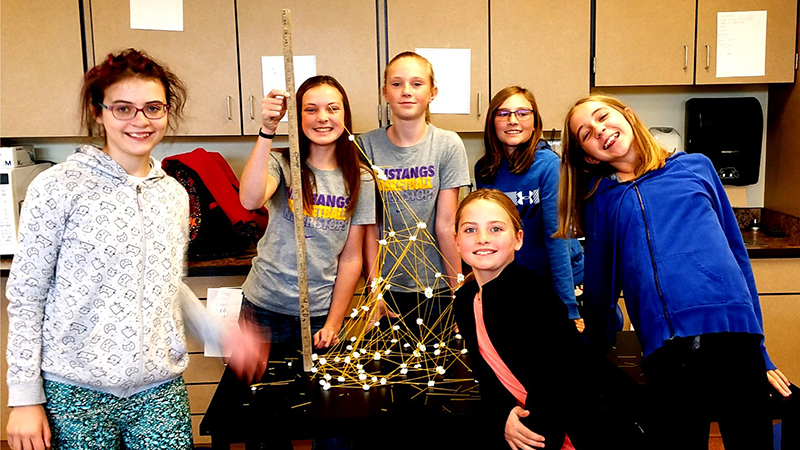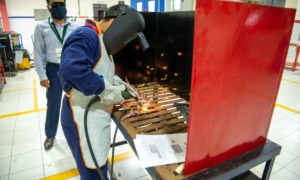
Elaine Menardi/Colorado AeroLab
West Grand Middle School practice engineering design and construction skills to create the tallest free-standing tower using spaghetti and marshmallows. This design challenge focused on the engineering principles related to project planning, materials strength and forces, and maintaining structural integrity.
In northern Colorado’s ski country, a rural area heavily reliant on tourism, some schools operate only four days a week.
The education nonprofit Colorado AeroLab, based in Kremmling (population 1,500), sees a special role in such areas for STEM education outside of school.
“Kids in these small, rural areas have a limited idea of the skills required [in careers],” said Elaine Menardi, chief innovator at AeroLab.
Not only does AeroLab bring science and technology education, it also sees the possibility of direct job creation as a result.
AeroLab operates four learning centers for middle and high school students in schools in Kremmling, Walden and Oak Creek, Colo. Last year, it served 212 students. The centers are open after school Monday through Thursday and all day on Friday, when kids aren’t in school.
The nonprofit, run by Menardi and Jess Buller, began in 2017 and served home-schooled students for a year. But it gained a 21st Century Community Learning Centers grant, and in 2018 it switched to providing the fifth-day program in three school districts.
“We could impact a wider range of kids and subject areas,” Menardi said. Their goal is to educate students for the jobs of the future.
And the free day from school on Friday allows a different approach to teaching science and technology, she said. Middle schoolers can learn perseverance and problem-solving. HIgh school students have a chance to earn credentials such as diploma endorsements and badges. They can develop their critical thinking, teamwork and professional skills, she said.
Partnerships with community leaders and businesses give kids a chance to take on local problems and design solutions, according to AeroLab. AeroLab also operates the P40 Lab, an internship program that began this fall with 10 students.
Kids challenged to use technology creatively
“The biggest benefit is the extra period of time to get into the flow of a project,” Menardi said. “They have the extra time to go deep into something that excites them. It’s a complementary approach to education.”
The after-school program offers homework help, Drone Club, a design lab with 3-D printers and robots, as well as a civics and debate program.
[Related: Is Four-day School Week Education Mistake Or Big Opportunity For Expanded Learning?]
Fridays have different options. There’s always a design challenge, Menardi said.
Kids might be given oddball materials such as tinfoil, paper, spaghetti and marshmallows and challenged to build a structure that can support the weight of a basketball. Or they might be given paper clips, string, index cards and tennis balls and challenged to move a tennis ball across the gym without touching it.
Kids work with different types of robots. Cubelets, for example, are used to build modular robots out of cubes that have different functions. The goal is to put them together to achieve a certain purpose. Kids may be asked to create a flashlight that turns on when the lights go out, for example.
Bloxells allows kids to create their own video game.
Each learning center has a 3-D printer. A favorite design challenge is to develop and print out a mini log cabin, Menardi said.
Creating jobs for small-town economy?
Fifth-day programming is perfect for career development and internships, according to Menardi.
“The potential is huge to motivate an entire community around its youth,” she said.
In fact Menardi sees a way to tie fifth-day work with kids to a community’s economic development. Kremmling, for example, does not have many professional services or tech-sector jobs.
“We think drones would be a good fit.” Menardi said. “We think there is a market.”
When a rancher or the Bureau of Land Management needs a drone — whether it’s to locate cattle, survey wildlife or map vegetation in an area — a local source for drones would be helpful.
Someone certified in drone operation could be that source, rather than a business in Denver, Menardi said.
3-D printing might also have potential, she said.
“You could develop a 3-D printer service to do replacement parts,” she said.
This story has been updated.





























